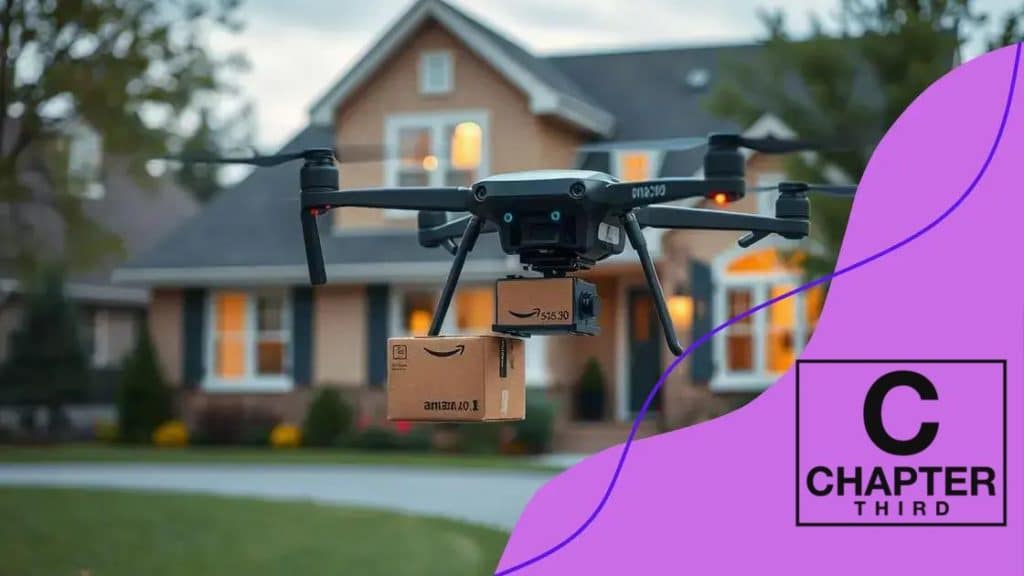Amazon unveils drone home delivery system that will amaze you

Amazon’s drone home delivery system promises faster, more efficient deliveries while reducing costs and environmental impact, aiming to revolutionize the logistics industry.
Amazon unveils drone home delivery system, and it’s creating quite a buzz. Have you ever imagined receiving your orders within minutes? In this article, we explore how this system can change the way we shop.
Understanding Amazon’s drone technology
Understanding Amazon’s drone technology is essential to grasp how they plan to revolutionize home deliveries. These drones are not just flying machines; they are a glimpse into the future of logistics. Designed for efficiency, these UAVs (unmanned aerial vehicles) aim to bring packages directly to your doorstep within minutes.
What Makes Amazon’s Drones Unique?
Amazon’s drones incorporate cutting-edge technology, making them capable of navigating complex urban environments. Their system includes advanced sensors and algorithms that help them avoid obstacles and deliver safely. Here are some key features:
- Autonomous Navigation: Drones can fly without human intervention, using GPS and onboard sensors.
- Real-Time Tracking: Customers can see the exact location of their package during the delivery.
- Eco-Friendly Design: Electric drones reduce carbon footprints compared to traditional delivery methods.
These features enhance the delivery experience, making it faster and more reliable. Besides technology, Amazon’s drone program complies with strict safety regulations, ensuring that deliveries are safe for both customers and the public.
The Delivery Process
So how does the delivery process work? It’s quite simple. When you place an order, the system identifies the nearest distribution center. From there, a drone loads your package and departs towards your location. The entire trip is meticulously planned to ensure efficiency and timeliness.
Furthermore, the drones can carry packages weighing up to five pounds, covering distances of up to 15 miles. This range allows for quick deliveries even in suburban areas. With Amazon leading the charge, it’s fascinating to consider what the future holds for delivery methods.
How drone delivery works in urban areas
Understanding how drone delivery works in urban areas helps us appreciate the advancements in logistics technology. Drones navigate complex city landscapes to deliver packages efficiently. They are designed to optimize routes and avoid obstacles, ensuring that deliveries are made swiftly.
Key Components of Urban Drone Delivery
Several factors contribute to the successful operation of drone delivery systems in cities. These include:
- Advanced Navigation Systems: Drones use GPS and sensors to find their way and avoid buildings and other obstacles.
- Real-Time Data Processing: Information about traffic and weather conditions is processed to determine the safest and fastest routes.
- Air Traffic Management: Collaboration with local authorities ensures that drones can operate safely in crowded airspace.
As drones fly, they can adjust their paths based on real-time data. This flexibility allows them to avoid unexpected issues like construction or adverse weather. The weight of the package also plays a crucial role; drones can carry packages of up to five pounds seamlessly through urban traffic.
The Delivery Process in the City
The delivery process starts when a customer places an order. The nearest delivery center efficiently prepares the package for shipment. Once ready, the drone takes off, guided by a meticulously planned route that minimizes flight time.
Upon reaching the destination, the drone carefully descends and releases the package. Customers receive notifications about the delivery status, allowing them to monitor the entire process. This level of transparency fosters trust in the service, making drone delivery an appealing option for urban residents.
Benefits of using drones for home deliveries

Exploring the benefits of using drones for home deliveries reveals how this technology can transform the way we receive goods. Drones offer a unique solution to common delivery challenges, making the entire process faster and more efficient.
Speed and Efficiency
Drones can quickly navigate urban areas, drastically reducing delivery times. Traditional delivery methods, such as trucks or vans, can be hindered by traffic and road conditions. Drones avoid these obstacles by flying directly to their destinations.
- Faster Deliveries: Customers can receive their orders in minutes rather than hours.
- Reduced Traffic Congestion: Drones help alleviate road traffic by using the airspace for deliveries.
- Cost-Effective Operations: Operational costs can be lower for drone deliveries, potentially reducing shipping fees for consumers.
Moreover, the precision of drone navigation ensures that packages are delivered to the correct location every time. This level of accuracy reduces the likelihood of missed deliveries, which often leads to customer dissatisfaction.
Environmental Benefits
The environmental impact of using drones is also noteworthy. These electric vehicles emit significantly less pollution compared to traditional delivery trucks. By optimizing delivery routes and using less energy, drones contribute to a greener planet.
Another crucial benefit is the ability to deliver to remote or hard-to-reach areas. This capability ensures that people living in rural regions also have access to fast and efficient delivery services. This expanded reach fosters inclusivity, allowing everyone to enjoy the advantages of modern delivery systems.
Challenges faced by drone delivery systems
Understanding the challenges faced by drone delivery systems is crucial for their successful implementation. While this technology offers numerous benefits, it also comes with significant hurdles that need to be addressed.
Regulatory Issues
One of the main challenges is navigating the complex regulations surrounding drone operations. Rules vary by region and often involve strict airspace regulations. Drone operators must ensure compliance with local, state, and federal laws to avoid penalties.
- Restricted Flight Zones: Many urban areas have designated no-fly zones, which can limit delivery options.
- Licensing Requirements: Drones often require special licensing to operate commercially, adding to operational costs.
- Privacy Concerns: The use of drones raises questions about surveillance and the privacy of citizens.
These regulatory challenges can slow down the deployment of drone delivery systems, making it essential for companies to work closely with government authorities.
Technical Limitations
In addition to regulatory issues, technical limitations pose further challenges. Drones must be equipped to handle various environmental conditions.
For example, flying in inclement weather can be difficult. High winds, rain, and snow can affect flight stability and safety. Additionally, drones have limited payload capacity, typically carrying packages that weigh under five pounds. This limitation restricts the types of items that can be delivered.
Furthermore, battery life remains a significant concern. Drones need adequate energy to complete their flights, and long-range deliveries may require frequent recharging or battery swaps. This can complicate operations and logistics.
Despite these challenges, continued advancements in technology and regulatory frameworks offer hope for the future of drone deliveries. With ongoing innovation, many of these hurdles may eventually be overcome.
The future of logistics with drone technology
Looking at the future of logistics with drone technology reveals exciting possibilities. Drones are set to change how goods are transported across various sectors. As technology continues to improve, the role of drones will expand significantly.
Integration with Current Systems
One of the key aspects of this future is the seamless integration of drones with existing logistics systems. Companies are exploring ways to combine drone deliveries with traditional methods. This hybrid approach can enhance efficiency and reduce costs.
- Last-Mile Delivery: Drones will play a vital role in last-mile delivery, bridging the gap between distribution centers and end consumers.
- Inventory Management: Drones equipped with scanning technology can help manage inventory levels in warehouses.
- Real-Time Tracking: The integration of drones with GPS systems will allow for precise tracking of shipments.
These integrations provide businesses with an enhanced ability to meet customer demands promptly. Furthermore, they can optimize operations, leading to increased profitability.
Advancements in Technology
Technological advancements are also paving the way for the future of drone logistics. Innovations in battery technology will allow drones to fly longer distances without needing to recharge.
Moreover, improvements in artificial intelligence will enable drones to navigate complex environments better. They will also be able to make real-time decisions based on changing conditions. As drones become smarter, their capabilities will expand, allowing them to handle more complex deliveries.
With the rise of automated delivery systems, the logistics landscape is set to undergo a significant transformation. This evolution promises faster, more reliable, and environmentally friendly solutions for transporting goods.
FAQ – Questions About Drone Delivery Systems
How do drone delivery systems work?
Drone delivery systems use GPS and sensors to navigate and deliver packages directly to customers’ doorsteps, minimizing delivery times.
What are the benefits of using drones for home deliveries?
Drones offer faster deliveries, reduced costs, and a smaller environmental impact compared to traditional delivery methods.
What challenges do drone delivery systems face?
Challenges include navigating regulations, technical limitations like battery life, and issues related to privacy and safety.
What is the future of logistics with drone technology?
The future of logistics will see greater integration of drones with existing systems, advancements in technology, and improved efficiency in deliveries.





